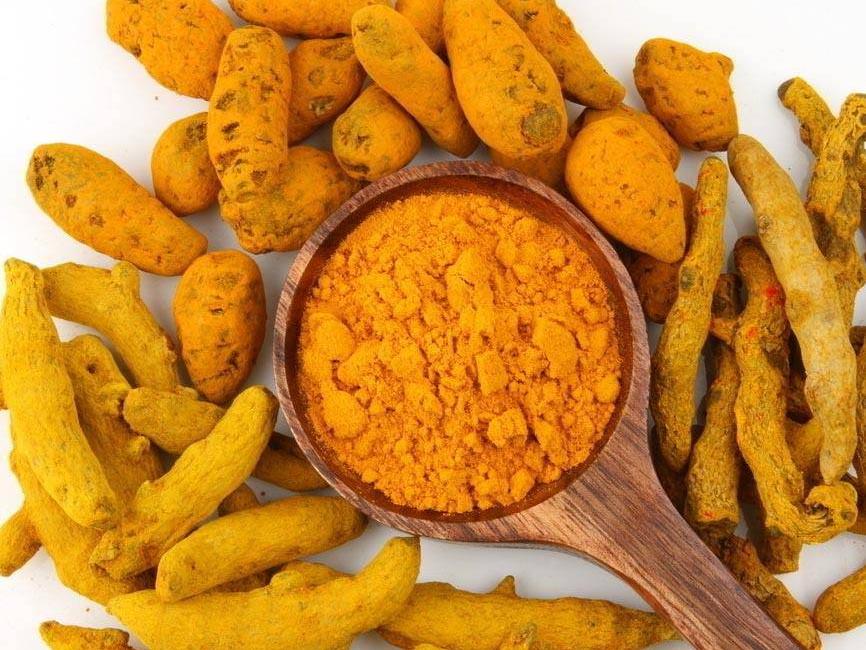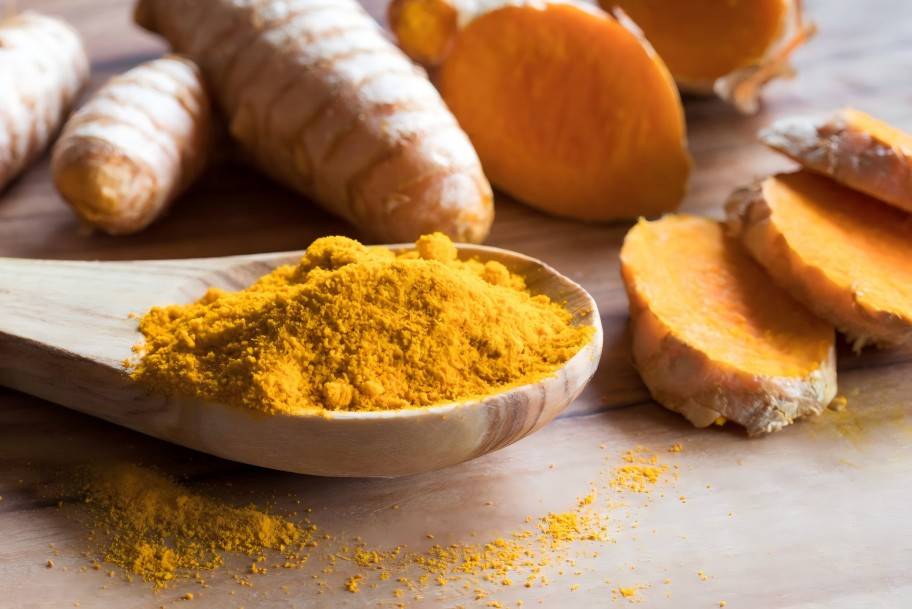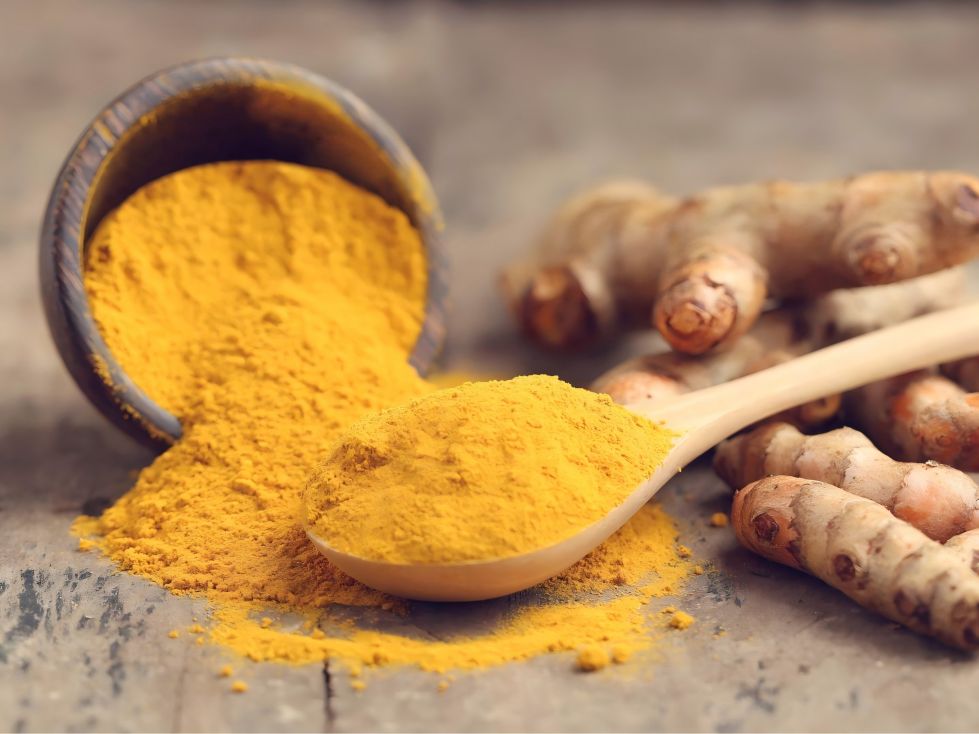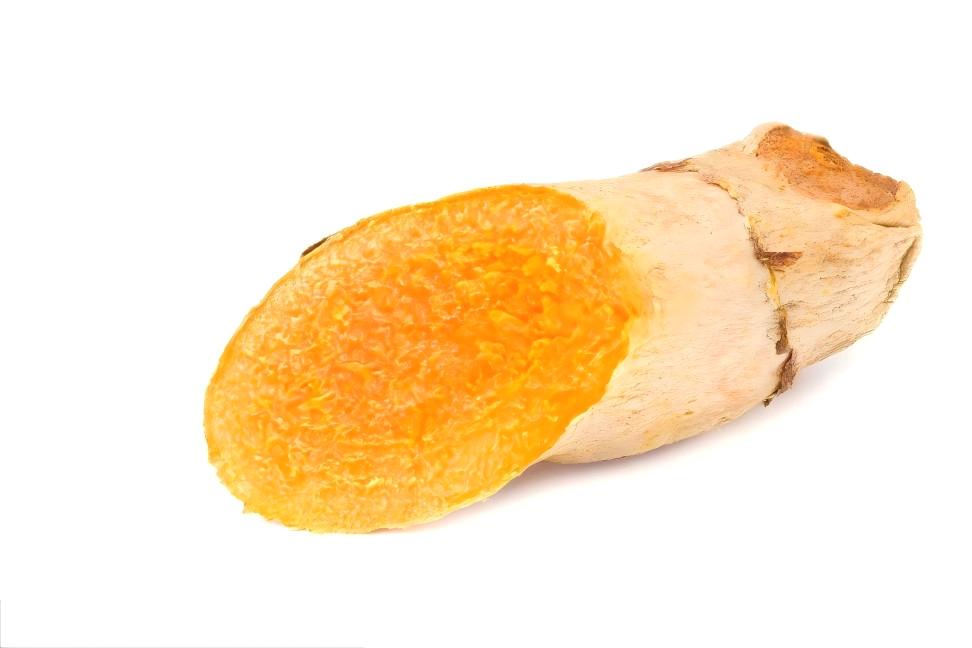Study on Curcumin Benefit for Liver
Curcumin is a natural compound that is a kind of diketone compound extracted from the rhizomes of plants in the ginger and araceae families (such as turmeric and saffron) [1]. Curcumin is native to the subtropical regions of South Asia and first appeared on the Indian subcontinent. It is also known as Indian saffron and curry powder [2]. It was introduced to Europe in the 13th century [3] and to the European and American continents as a spice in the 15th century [4]. In 1815, curcumin was first purified from turmeric [5]. In recent years, curcumin has become increasingly well known as a functional substance for health and medicine [6-7]. Curcumin has a wide range of uses and has attracted the attention of scholars at home and abroad, especially for its anti-inflammatory and antioxidant effects.
Curcumin is a food additive approved by the Food and Agriculture Organization of the United Nations Codex Alimentarius Commission (FAO/WHO-1995), a safe food additive certified by the US Food and Drug Administration (FDA), and a food additive permitted for use in China's “Food Additive Use Standards” (GB 2760-2011). Its safety as a food additive is beyond doubt. Curcumin is not only widely used as a natural pigment in food additives, such as for processing canned foods and marinated products, but also in the animal feed industry because of its good bactericidal, anti-inflammatory and antioxidant properties[8].
However, the use of curcumin as a feed additive in animal husbandry is not widely accepted by feed processing and breeding companies due to its cost, and its application and promotion in China is relatively lagging. With the rapid development of China's economy, people have higher and higher quality requirements for animal products, and higher and higher safety requirements for livestock and poultry feed additives. The Ministry of Agriculture and Rural Affairs of the People's Republic of China has issued Announcement No. 194, which stipulates that starting from January 1, 2020, “all varieties of growth-promoting drug feed additives except traditional Chinese medicine will be withdrawn”, and animal feed will be completely “anti-antibiotic”. Curcumin is used as a Chinese herbal medicine additive in the healthy feeding of animals. Because it is natural, environmentally friendly and has certain functional properties, research into it has begun to be taken seriously. Therefore, this paper introduces the physiological and biochemical properties, immune properties, antioxidant and other biological functions of curcumin, describes the progress of its application in pig production, and looks ahead to future research.
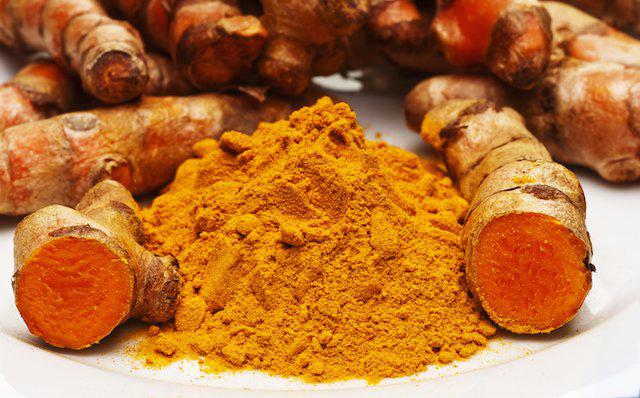
1 Molecular structure and physicochemical properties of curcumin
1.1 Physicochemical properties of curcumin
Curcumin is an orange-yellow crystalline powder that is insoluble in water but soluble in glacial acetic acid, ethanol, propionaldehyde and alkaline solutions. It has a slightly bitter taste and a melting point of 183 °C. Curcumin is highly reactive chemically [11] and is reddish-brown in alkaline conditions and yellow in neutral or acidic conditions. When curcumin is dissolved in a solution, it exists in the form of phenols and can scavenge free radicals. Curcumin has an absorbance value of 415–420 nm and is prone to decomposition at high temperatures or in strong light, producing aldehydes and alkanes [12].
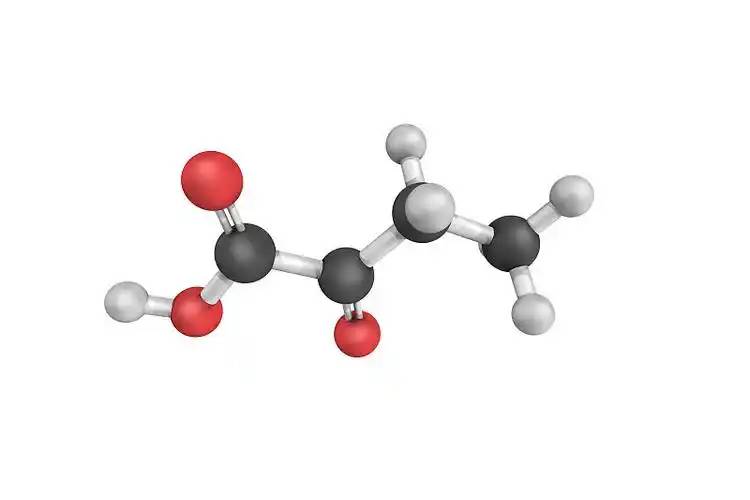
2 Biological functions of curcumin
2. 1 Curcumin's anti-inflammatory and antibacterial effects
Most chronic diseases (such as arthritis, gastritis, pancreatitis, etc.) are caused by a disruption of the body's inflammatory regulatory balance. Further deepening of the inflammation can cause tissue damage or even necrosis. Curcumin contains active ingredients that can inhibit inflammatory factors such as tumor necrosis factor (TNF-α, INF- γ), interleukin (IL), interferon ( γ), etc., and transcription factors (AP-1), mediating inflammation-related signal pathways (NF-κB), thereby playing a therapeutic role. Shishodia [13] research shows that curcumin exerts its antibacterial and anti-inflammatory effects by inhibiting the activity of nuclear factors in the P38 MAPK signaling pathway, which can enhance the body's immune regulation function, reduce inflammation in the body, and further studies have found that its targets are growth factors, transcription, and inflammatory factors. Julie et al. [14] showed that curcumin can upregulate the expression of IL-10, downregulate COX-2, inducing the expression of iNOS enzyme to achieve the effect of antibacterial and anti-inflammatory. Ghosh et al. [15] found that in the construction of a mouse model of acute kidney injury, after treatment with curcumin, the expression of NF-κB in the mouse kidney decreased, the secretion of TNF-α factor was inhibited, and the reduction of inflammation in the mouse reduced the degree of kidney damage.
The above studies show that curcumin can inhibit the activity of related enzymes and suppress inflammatory factors by blocking metabolic reactions, thereby inhibiting chronic inflammation such as gastritis and pancreatitis. Antony et al. [16] fed turkeys with curcumin and then detected its effect on the routine blood indicators of the turkeys. They found that curcumin increased the white blood cell (WBC) count and red blood cell (RBC) count in the blood of the turkeys. The reason for this may be that curcumin contains bioactive functions. When chicken tissue mucosal lymph T cells and B cells were treated with curcumin, it was found that it can regulate lymph T cell and lymph B cell-mediated immune function [17-18].
South et al. [19] fed mice with a curcumin dose of 40 g/kg for 5 weeks, the content of immunoglobulin IgG in mouse serum increased significantly, and the immunity of mice improved, enhancing their disease resistance. Curcumin not only enhances the body's immune capacity, but also directly kills bacteria that cause human diseases such as pneumonia and meningitis, such as gram-positive bacteria (Staphylococcus aureus, enterococci, etc.) and gram-negative bacteria [20]. Curcumin was used to inhibit Escherichia coli, and it was found that it can upregulate the expression of the apoptotic protein RecA in the bacteria, thereby inducing the accumulation of reactive oxygen species (ROS) and calcium ion influx in Escherichia coli [21]. Curcumin has a certain inhibitory rate against viruses and even aflatoxins.
Jeong et al. [22] found that curcumin can inhibit the ratio of F-actin/G-actin during viral entry and inhibiting further infection by VHSV. Yarru et al. [23] found that adding curcumin to aflatoxin-containing chicken feed can significantly reduce the toxicity of aflatoxin to broilers at certain doses.
Curcumin can directly kill related bacteria through its own biological activity, and enhance the body's immunity by inhibiting inflammatory factors or related signal pathways, thereby achieving the effect of antibacterial and anti-inflammatory.
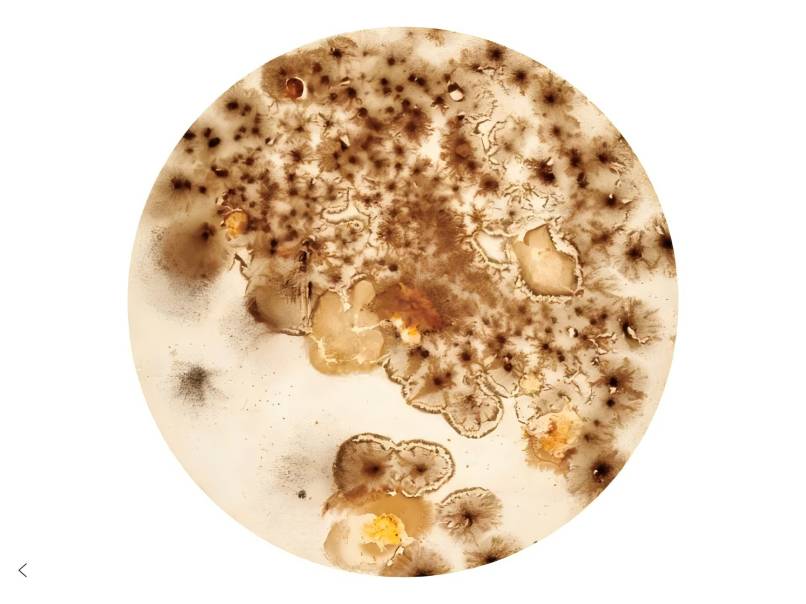
2. 2 The antioxidant effect of curcumin
The physiological processes of aging or disease in living organisms are often closely related to excessive free radicals in the body. Curcumin can improve the activity of antioxidant enzymes, reduce oxidative stress, and exert an antioxidant effect. Under normal circumstances, the body's own antioxidant system can remove free radicals. However, when the body is under stress, a large number of free radicals are produced, and when the antioxidant system is unable to remove them, these free radicals will attack cells and cause oxidative damage to tissues [24].
Curcumin has a β-diketone and two o-methylated phenols. This unique chemical structure can block the reaction of free radicals, and the methoxy group further enhances the antioxidant capacity, thereby improving the body's antioxidant effect [25]. Ammon et al. [26] found in a study of the effect of curcumin on free radicals that curcumin can scavenge free radicals in macrophages, protect hemoglobin and lipids from oxidation, and its antioxidant capacity is comparable to that of vitamins C and E.
In addition to its ability to remove excess free radicals from the body and its antioxidant properties, curcumin can also enhance the activity of antioxidant enzymes such as glutathione peroxidase (GSH-PX) and superoxide dismutase (SOD), thereby enhancing the body's antioxidant capacity [27]. Ruan et al. [28] found through a study of the effects of curcumin on the intestines of piglets that curcumin can increase the expression of related genes such as CAT, HO-1, Nrf2 and SOD1 in the piglet's large intestine, thereby increasing the activity of SOD and GSH-PX in the piglet's intestine and thus enhancing the antioxidant capacity of the piglet's intestine. Curcumin has also been shown to be a bifunctional antioxidant that can scavenge reactive oxygen species (ROS) and induce antioxidants, prevent lipid and protein oxidation, activate SOD and GSH-PX activity, and reduce MDA levels [29-30].
Luo et al. [31] investigated the effects of curcumin on mouse skeletal muscle. The study showed that curcumin can significantly increase Nrf2 activity and reduce malondialdehyde (MDA) levels, thereby alleviating oxidative stress in skeletal muscle. Waseem et al. [32] found in a rat model of oxidative damage that curcumin can significantly increase SOD activity in rat mitochondria and and reduced the MDA content. The degree of oxidative damage in the rats was reduced.
Perker et al. [33] showed that curcumin can inhibit hydrogen peroxide, hydroxyl radicals and lipid peroxidation, and reduce the oxidative damage caused by peroxidation to fibroblasts, thanks to the characteristics of its molecular structure. In addition, it has been found that curcumin can activate peroxisome proliferator-activated receptor γ (PPAR-γ) protein by inhibiting redox transcription factors, or reduce the activity of peroxisome proliferator-activated receptor (PPAR), to relieve oxidative stress in the body [34-35]. Chinese scholars have also conducted a large number of studies on the antioxidant effects of curcumin, and the results show that curcumin uses its own molecular structure to recognize relevant signal transduction molecules in the body, and by regulating relevant signal pathways, enhances the activity of relevant enzymes, reduces the content of free radicals or regulates the expression of relevant genes, improves oxidative stress, and exerts an antioxidant effect.
Curcumin has a unique polyphenol molecular structure that allows it to enter cell membranes and bind to intracellular free radicals to produce stable phenolic compounds, thereby removing reactive oxygen species in cells, inhibiting peroxidation damage mediated by the activity of intracellular free radicals, and at the same time increasing the activity of SOD, T-AOC, GSH-PX and other activities in cells to improve the antioxidant capacity of cells.
2. 3 The liver protection and liver-preserving effect of curcumin
The liver-protecting effect of curcumin is mainly achieved by regulating the body's lipid metabolism, modulating related lipid oxidation signal pathways, reducing excessive free radicals in the body, lowering the total cholesterol (TC), triglycerides (TG), and low-density lipoprotein cholesterol (LDL-C) in the body's serum, and increase high-density lipoprotein cholesterol (HDL-C). Yang et al. [36] found that the TG and TC levels in the serum of mice fed a diet containing curcumin were significantly reduced. Curcumin not only reduces TG and TC, but also lowers LDL-C and increases HDL-C, achieving the effect of protecting and nourishing the liver.
Manzoni et al. [37] studied the effect of curcumin on blood lipids in rats and found that curcumin can significantly reduce TG in rats, increase HDL-C levels in the serum, and prevent liver fat accumulation in rats. In addition, curcumin can also inhibit lipid oxidation by inhibiting the level of free radicals such as ROS and reducing the level of MDA. Lee et al. [38] showed that when constructing an artificial induced mouse injury model, curcumin was found to be able to regulate endoplasmic reticulum stress by inhibiting the expression level of ROS in the liver and regulate endoplasmic reticulum stress to alter its folding state, and restore liver function in mice. Reddy et al. [39] showed in an iron-induced liver damage test in rats that liver damage was significantly reduced after feeding a diet supplemented with 30 mg/kg turmeric for 10 days, which was attributed to the ability of curcumin to reduce lipid oxidation in rats.
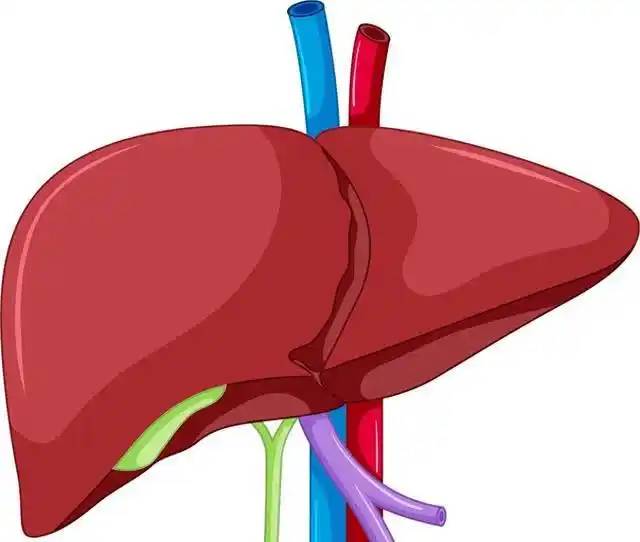
Curcumin activates the activity of the antioxidant enzyme Nrf2, reduces the expression of genes related to pro-inflammatory factors, reduces the levels of MDA and ROS, and restores the liver's antioxidant capacity [40]. Curcumin can also lower blood glucose, improve fat consumption by regulating the active enzyme pathway in the liver, and inhibit the formation of fatty liver due to lipid deposition in the liver. Niu et al. [41] showed that after pigs were fed a diet supplemented with curcumin for 30 days, blood glucose (Glu) was reduced, and insulin resistance index (HOMA-IR) was reduced by regulating the body's insulin signaling pathway, reduced liver lipid deposition. Kobori et al. [42] showed that curcumin protected the liver from damage by inhibiting diacylglycerol expression by reducing the expression of two enzymes in the mouse liver (glycerol-3-phosphate acyltransferase 1 and glycerol-3-phosphate acyltransferase).
Tranchida et al. [43] found that curcumin can regulate choline metabolism, increase fat consumption, and reduce fat around the liver, thereby preventing fatty liver. Luo et al. [31] found that curcumin regulates signal pathways by inhibiting Kelch-like ECH-associated protein 1 (Keap1) and also activated Nrf2 activity, reducing the damage to the liver caused by excessive free radical oxidation. Tokac et al. [44-45] showed that curcumin can significantly reduce the level of TNF-α in the liver and reduce the damage caused to the liver by cholestasis. The liver damage is reflected in the liver function-related indicators, which are biochemical indicators in the serum, such as alanine aminotransferase (ALT), alkaline phosphatase (ALP), GLU, TG, HDL-C, LDL-C, etc. Abnormalities in these indicators are mainly due to excessive free radicals in the body, or excessive lipid metabolism, resulting in fat deposition and causing liver damage.
Curcumin protects the liver by regulating lipid oxidation-related signaling pathways, activating Nrf2-like activity, inhibiting the expression of free radicals such as ROS, reducing the content of MDA, inhibiting lipid metabolism and oxidation, and achieving the effect of protecting and nourishing the liver.
2. 4 Anti-tumor effect of curcumin
Tumors are caused by tumor-causing factors that cause local tissue cells to lose control and proliferate indefinitely, forming new tissue that is a space-occupying mass and has a different biological metabolism from normal cells. Curcumin can inhibit the unlimited proliferation of tumor cells and achieve an anti-tumor effect by regulating the expression of related proteins or inhibiting the expression of proteins and mRNA. In addition, curcumin has many molecular targets, and research on its anti-tumor effects began in the late 20th century[46]. He et al.[47] found in an in vitro experiment that curcumin can inhibit the transcription and protein levels of the NF-κB nuclear factor, vascular endothelial growth factor (VEGF), and Notch1 receptor, thereby inhibiting the unlimited proliferation of tumor cells and controlling their growth. Endothelial dilator factor (NO) is an initiator of tumors and also participates in the stages of tumor transformation and promotion. It can stimulate VEGF expression and affect tumor development. Curcumin can significantly inhibit NO and also inhibit various tumor necrosis factors, which has a significant effect on the treatment of tumors and related diseases caused by tumors [48].
Li et al. [49] showed that curcumin can also inhibit the Wnt/β-catenin signaling pathway by regulating the expression of miRNA-130a and RNA-491 to control the unlimited proliferation of tumor cells. Curcumin can inhibit the proliferation of various tumor cells, such as lung cancer, liver cancer, intestinal cancer, breast cancer, pancreatic cancer, etc., and produce an anti-tumor effect by inhibiting the activity of tumor necrosis factor. Zhou et al. [50] found in a study of the anti-lung cancer effect of curcumin that curcumin can inhibit tumor cell activity and promote apoptosis of lung cancer cells by inducing autophagy in the body's own cells, thereby achieving an anti-lung cancer effect.
Chuang et al. [51] found in a rat liver tumor experiment that curcumin significantly inhibited the expression of the liver carcinogenic proteins P53 and P21, and selectively reduced the expression of P34 and cyclin E, but had no effect on cyclin D. Li et al. [52] found in a nude mouse model of pancreatic cancer that curcumin inhibited the expression of VEGF, IL-8, and CD31, inhibit the formation of vascular tumors, significantly inhibit the proliferation of pancreatic tumor cells, and have a certain anti-pancreatic tumor effect. Poma et al. [53] found in a study of the effect of curcumin on breast cancer that curcumin can regulate estrogen and non-estrogen receptor signaling pathways, inhibit the activity of related enzymes such as ROS, reduce the expression of VEGF, reduce breast tumor angiogenesis, and induce apoptosis of breast tumor cells.
The mechanism of curcumin's anti-tumor effect is: 1) inhibiting related tumor necrosis factors to reduce tumor tissue formation; 2) regulating the expression of tumor-related genes to promote apoptosis of tumor cells; 3) inhibiting the activity of tumor-related enzymes or regulating the activity of anti-tumor-related enzymes to significantly improve the efficacy of tumor treatment.
3 Application of curcumin in pig production
The main purposes of curcumin in pig production are: replacing antibiotics, promoting growth and improving meat quality. The replacement of antibiotics occurred after the complete ban on antibiotics in Chinese feed. Curcumin began to be widely used to exert its antibacterial and anti-inflammatory functions. Growth promotion mainly uses the functions of curcumin to resist stress and protect the intestinal mucosa. Improving meat quality mainly uses the functions of curcumin to resist oxidation, protect the liver and so on. Of course, there are other functions that play a role in pig production, but their ultimate goal is to improve the economic benefits of pig production. Xun et al. [54] found in a study on piglet weaning that compared to quinolone, curcumin can significantly improve the intestinal mucosal barrier integrity of weaned piglets, significantly improve the intestinal flora, and improve piglet immunity. turmeric extract can completely replace quinolone as a feed additive. Fu et al. [55] showed that curcumin inhibits virus replication by binding to the relevant viral specific enzymes, RNA polymerase, and viral envelope proteins, reducing infection and damage to cells and alleviating the symptoms of viral infection in pigs. Ilsley et al. [56] found that After weaning piglets were fed a diet supplemented with curcumin, the diarrhea rate and mortality rate of piglets decreased, and the growth rate of weaned piglets increased significantly, indicating that curcumin can improve the immunity of piglets.
Gan et al. [57] showed that curcumin can improve piglet immunity by regulating the TLR4 signaling pathway, inhibiting inflammatory factors, and protecting the intestinal flora of piglets. Wei et al. [58] found that feeding curcumin 21 days before slaughter can significantly reduce serum cortisol, down-regulate the expression of cNOS, inhibiting the activity of cNOS enzyme, thereby improving the stress resistance of pigs during transport. Curcumin not only has antibacterial and anti-inflammatory properties, enhancing the pigs' resistance to bacteria and viruses, but also relieves the damage caused by various stresses to pigs. In terms of improving the quality of pork, curcumin can improve the physiological and biochemical indicators of pig blood, reduce the damage to internal organs such as the liver during pig feeding, improve the health of pigs, reduce PSE meat and DFD meat produced by pig stress, and improve the quality of pork. Lu et al. [59] found that pigs fed a diet supplemented with curcumin alleviated LPS-induced liver damage and endocrine and metabolic disorders in piglets by methylation modification of mRNA. If the MDA content in the pig's body is too high, lipid oxidation will be more severe and the meat quality will be worse.
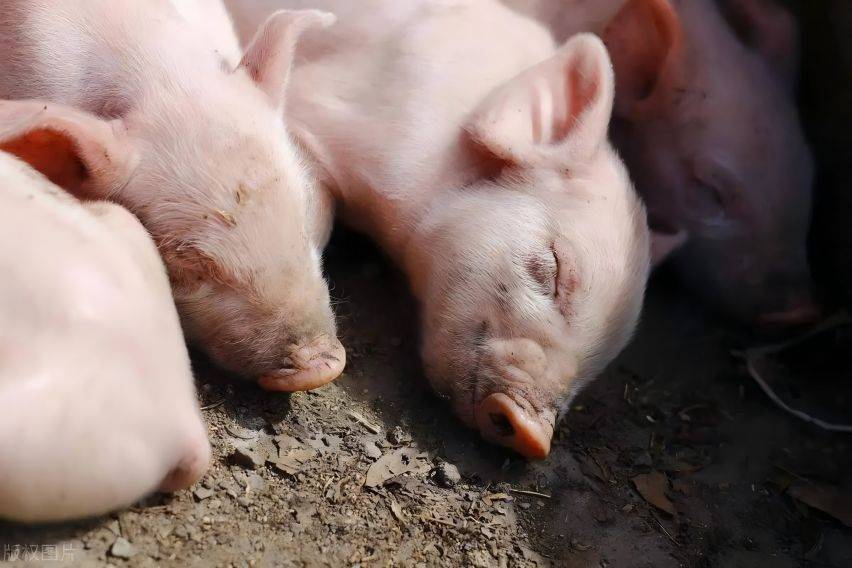
Huang et al. [60] showed that curcumin can inhibit the metabolism of arachidonic acid and reduce the oxidative decomposition of unsaturated fatty acids in the body. Unsaturated fatty acids in the body are highly correlated with pork quality. Curcumin can inhibit the level of free radicals in the body, alleviate the oxidative decomposition of unsaturated fatty acids in the body, and thus improve pork quality. In addition, pork contains a lot of fat. If the fat oxidizes, the quality of the pork will plummet, the color and flavor of the pork will change, and the health of the human body will be affected after consumption. Curcumin also contains a lot of trace elements, such as calcium, zinc, and selenium, which can improve the indicators of pork such as unsaturated fatty acids, tenderness, and intramuscular fat, thereby changing the quality of pork. Some Chinese scholars have also conducted research on the application of curcumin in production, mostly focusing on research on alternative products to antibiotics. There has been less research on improving the quality of pork, and the conclusions are inconsistent, which may be related to the purpose of the experiment, the breed of the pigs in the experiment, and the environment, or to the source of curcumin used by the researcher.
4 Outlook
As the socio-economic level continues to develop, people have increasingly high expectations for the quality of life. Therefore, the quality of meat is not only required to be safe, but also nutritious and delicious. According to data from the National Bureau of Statistics' “Communiqué of the People's Republic of China on National Economic and Social Development in 2021,” China's annual pork production in 2021 was 52.96 million tons, an increase of 28.8% over 2020. The safety and quality of pork is related to people's livelihood in China. With the implementation of a comprehensive feed ban on antibiotics in China, alternative antibiotic products are becoming increasingly important, and consumers are increasingly demanding safe, natural, and harmless products. Curcumin is a natural substance extracted from plants, and it has already been used as a feed additive in animal production, especially pig production.
However, most of the current research on curcumin in China focuses on the treatment of animal diseases, which may be related to the direct economic benefits for animals. Animal producers pay more attention to antibacterial and anti-inflammatory products, resulting in a high demand for research in this area. There has been more research on curcumin in poultry farming, and the main focus in China has been on the effect of curcumin on the quality of broiler chickens. However, the research on the antioxidant effect of curcumin, such as its mechanism in promoting piglet production and enhancing piglet immunity, is not in-depth and needs to be further explored. There have been relatively few studies on the antioxidant and nutrient properties of curcumin to improve the quality of livestock and poultry meat, especially pork. Only a small number of researchers have studied the effects of curcumin on changing the pH value, meat color and marbling of pork. With the wide application of curcumin, it will play an increasingly important role in animal production, especially in pig production, not only involving improving animal health, but also animal feeding nutrition, metabolism and bioavailability.
Reference:
[ 1 ] HENROTIN Y,GHARBI M,DIERCKXSENS Y,et al. Decrease of a specific biomarker of collagen degradation in osteoarthritis,Coll2-1 ,by treatment with highly bioavailable curcumin during an exploratory clinical trial[J]. BMC Complementary and Alternative Medicine,2014 ,14 : 159.
[ 2 ] AGGARWAL B B ,SUNDARAM C ,MALANI N,et al. Curcumin:the Indian solid gold[J]. Advances in Experimental Medicine and Biology, 2007 ,595 :1-75.
[ 3 ] YONG C C ,YOON Y,YOO H S,et al. Effect of Lactobacillus fermentation on the anti-inflammatory potential of turmeric [J]. Journal of Microbiology and Biotechnology,2019 ,29(10):1561-1569.
[ 4 ] ROLFE V,MACKONOCHIE M,MILLS S,et al. Turmeric∕curcumin and health outcomes:a meta-review of systematic reviews [J]. European Journal of Integrative Medicine,2020 ,40 :101252.
[ 5 ] SOGI D S,SHARMA S,OBEROI D P S,et al. Effect of extraction parameters on curcumin yield from turmeric[J]. Journal of Food Science and Technology,2010 ,47(3):300-304.
[ 6 ] NAAMA J H,AL-TEMIMI A A,HUSSAIM AL et al. Study the antivities of ethanolic curcumin extract[J]. African Journal of Pure and Applied Chemistry,2010 ,4(5):68-73.
[ 7 ] AMALRAJ A,PIUS A,GOPI S,et al. Biological activities of curcuminoids,other biomolecules from turmeric and their derivatives-A review[J]. Journal of Traditional and Complementary Medicine,2017 ,7(2):205-233.
[ 8 ] MOHAMMADI S,KAYEDPOOR P,KARIMZADEHBARDEI L,et al. The effect of curcumin on THN-α ,IL-6 and CRP expression in a model of polycystic ovary syndrome as an inflammation state[J]. Journal of Reproduction & Infertility,2017 ,18(4):352-360.
[ 9 ] YANG Q,WU S,MAO X,et al. Inhibition effect of curcumin on TNF-α and MMP-13 expression induced by advanced glycation and products in chondrocytes[J]. Pharmacology,2013 ,91(1 ∕2):77-85.
[10 ] KIUCHI F,GOTO Y,SUGIMOTO N,et al. Nematocidal activity of turmeric:synergistic action of curcuminoids[J]. Chemical & Pharmaceutical Bulletin,1993 ,41(9):1640-1643.
[11 ] GOEL A,KUNNUMAKKARA A B ,AGGARWAL B B. Curcumin as“Curecumin”:from kitchen to clinic[J]. Biochemical Pharmacology,2008 , 75(4):787-809.
[12 ] WANG Y J,PAN M H,CHENG A L,et al. Stability of curcumin in buffer solutions and characterization of its degradation products[J]. Journal of Pharmaceutical and Biomedical Analysis,1997 ,15(12):1867-1876.
[13 ] SHISHODIA S. Molecular mechanisms of curcumin action:gene expression[J]. Biofactors,2013 ,39(1):37-55.
[14 ] JURENKA J S. Anti-inflammatory properties of curcumin,a major constituent of Curcuma longa:a review of preclinical and clinical research[J]. Alternative Medicine Review :a Journal of Clinical Therapeutic,2009 ,14(2):141-153.
[15 ] GHOSH S S,MASSEY H D,KRIEG R,et al. Curcumin ameliorates renal failure in 5 ∕6 nephrectomized rats:role of inflammation[J]. American Journal of Physiology Renal Physiology,2009 ,296(5):F1146-F1157.
[16 ] ANTONY S,KUTTAN R,KUTTAN G. Immunomodulatory activity of curcumin[J]. Immunological Investigations,1999 ,28(5 ∕6):291-303.
[17 ] CHURCHILL M,CHADBURN A,BILINSKI R T,et al. Inhibition of intestinal tumors by curcumin is associated with changes in the intestinal immune cell profile[J]. Journal of Surgical Research,2000 ,89(2):169-175.
[18 ] ALSULTAN S,ARABIA S. The effect of Curcuma longa (tumeric) on overall performance of broiler chickens [J]. International Journal of Poultry Science,2003 ,2(5):351-353.
[19 ] SOUTH E H,EXON J H,HENDRIX K. Dietary curcumin enhances antibody response in rats[J]. Immunopharmacology and Immunotoxicology, 1997 ,19(1):105-119.
[20 ] MISHRA S,NARAIN U,MISHRA R,et al. Design,development and synthesis of mixed bioconjugates of piperic acid-glycine,curcumin-glycine∕ alanine and curcumin-glycine-piperic acid and their antibacterial and antifungal properties [ J ]. Bioorganic & Medicinal Chemistry,2005 , 13(5):1477-1486.
[21 ] MANDELKER L. Oxidative Stress, Free Radicals, and Cellular Damage [ M ]∕∕MANDELKER L, VAJDOVICH P. Studies on Veterinary Medicine. Totowa N J:Humana Press,2011.
[22 ] JEONG E H,VAIDYA B ,CHO S Y,et al. Identification of regulators of the early stage of viral hemorrhagic septicemia virus infection during curcumin treatment[J]. Fish & Shellfish Immunology,2015 ,45(1):184-193.
[23 ] YARRU L P,SETTIVARI R S,GOWDA N K S,et al. Effects of turmeric( Curcuma longa) on the expression of hepatic genes associated with biotransformation,antioxidant,and immune systems in broiler chicks fed aflatoxin[J]. Poultry Science,2009 ,88(12):2620-2627.
[24 ] ST-PIERRE N R,COBANOV B ,SCHNITKEY G. Economic losses from heat stress by US livestock industries[J]. Journal of Dairy Science, 2003 ,86 :E52-E77.
[25 ] JOE B ,LOKESH B R. Role of capsaicin,curcumin and dietary n-3 fatty acids in lowering the generation of reactive oxygen species in rat
peritoneal macrophages[J]. Biochimica et Biophysica Acta(BBA)-Molecular Cell Research,1994 ,1224(2):255-263. [26 ] AMMON H P,WAHL M A. Pharmacology of Curcuma longa[J]. Planta Medica,1991 ,57(1):1-7.
[27 ] PULLA REDDY A C ,LOKESH B R. Effect of dietary turmeric(Curcuma longa) on iron-induced lipid peroxidation in the rat liver[J]. Food and Chemical Toxicology,1994 ,32(3):279-283.
[28 ] RUAN D,ZHU Y W,FOUAD A M,et al. Dietary curcumin enhances intestinal antioxidant capacity in ducklings via altering gene expression of antioxidant and key detoxification enzymes[J]. Poultry Science,2019 ,98(9):3705-3714.
[29 ] ASHRAFIZADEH M,AHMADI Z,MOHAMMADINEJAD R,et al. Curcumin activates the Nrf2 pathway and induces cellular protection against oxidative injury[J]. Current Molecular Medicine,2020 ,20(2):116-133.
[30 ] ABRAHAMS S,HAYLETT W L,JOHNSON G,et al. Antioxidant effects of curcumin in models of neurodegeneration,aging,oxidative and nitrosative stress:a review[J]. Neuroscience,2019 ,406 :1-21.
[31 ] LUO D D,CHEN J F,LIU J J,et al. Tetrahydrocurcumin and octahydrocurcumin,the primary and final hydrogenated metabolites of curcumin, possess superior hepatic-protective effect against acetaminophen-induced liver injury:role of CYP2E1 and Keap1-Nrf2 pathway[J]. Food and Chemical Toxicology,2019 ,123 :349-362.
[32 ] WASEEM M,PARVEZ S. Mitochondrial dysfunction mediated cisplatin induced toxicity:Modulatory role of curcumin[J]. Food and Chemical Toxicology,2013 ,53 :334-342.
[33 ] PERKER M C ,ORTA YILMAZ B ,YILDIZBAYRAK N,et al. Protective effects of curcumin on biochemical and molecular changes in sodium arsenite-induced oxidative damage in embryonic fibroblast cells[J]. Journal of Biochemical and Molecular Toxicology,2019 ,33(7):e22320.
[34 ] SIDDIQUI A M,CUI X X,WU R Q,et al. The anti-inflammatory effect of curcumin in an experimental model of Sepsis is mediated by up- regulation of peroxisome proliferator-activated receptor-gamma[J]. Critical Care Medicine,2006 ,34(7):1874-1882.
[35 ] BLANQUICETT C ,KANG B Y,RITZENTHALER J D,et al. Oxidative stress modulates PPAR gamma in vascular endothelial cells[J]. Free Radical Biology & Medicine,2010 ,48(12):1618-1625.
[36 ] YANG J W,YEO H K,YUN J H,et al. Theracurmin(highly bioavailable curcumin) prevents high fat diet-induced hepatic steatosis development in mice[J]. Toxicological Research,2019 ,35(4):403-410.
[37 ] MANZONI A G,PASSOS D F,DA SILVA J L G,et al. Rutin and curcumin reduce inflammation,triglyceride levels and ADA activity in serum and immune cells in a model of hyperlipidemia[J]. Blood Cells,Molecules,and Diseases,2019 ,76 :13-21.
[38 ] LEE H Y,KIM S W,LEE G H,et al. Curcumin and Curcuma longa L. extract ameliorate lipid accumulation through the regulation of the endoplasmic Reticulum redox and ER stress[J]. Scientific Reports,2017 ,7 :6513.
[39 ] REDDY A C P,LOKESH B R. Effect of curcumin and eugenol on iron-induced hepatic toxicity in rats[J]. Toxicology,1996 ,107(1):39-45. [40 ] DAS L,VINAYAK M. Curcumin modulates glycolytic metabolism and inflammatory cytokines via Nrf 2 in dalton’s lymphoma ascites cells in vivo[J].Anti-Cancer Agents in Medicinal Chemistry,2018 ,18(12):1779-1791.
[41 ] NIU Y,HE J T,AHMAD H,et al. Curcumin attenuates insulin resistance and hepatic lipid accumulation in a rat model of intra-uterine growth restriction through insulin signalling pathway and sterol regulatory element binding proteins[J]. The British Journal of Nutrition,2019 ,122(6): 616-624.
[42 ] KOBORI M,TAKAHASHI Y,TAKEDA H,et al. Dietary intake of curcumin improves eIF2 signaling and reduces lipid levels in the white adipose tissue of obese mice[J]. Scientific Reports,2018 ,8 :9081.
[43 ] TRANCHIDA F,RAKOTONIAINA Z,SHINTU L,et al. Hepatic metabolic effects of Curcuma longa extract supplement in high-fructose and saturated fat fed rats[J]. Scientific Reports,2017 ,7 :5880.
[44 ] TOKAC M,TANER G,AYDIN S,et al. Protective effect of curcumin against oxidative stress parameters and DNA damage in the livers and kidneys of rats with biliary obstruction[J]. Food & Chemical Toxicology,2013 ,61(4):28-35.
[45 ] AHMADI F. Effect of turmeric(Curcumin longa) powder on performance,oxidative stress state and some of blood parameters in broiler fed on diets containing aflatoxin B1[J]. Global Veterinaria,2010 5(6):312-317.
[46 ] MENON V P,SUDHEER A R. Antioxidant and anti-inflammatory properties of curcumin[J]. Advances in Experimental Medicine and Biology, 2007 ,595 :105-125.
[47 ] HE G F,MU T L,YUAN Y L,et al. Effects of Notch signaling pathway in cervical cancer by curcumin mediated photodynamic therapy and its possible mechanisms in vitro and in vivo[J]. Journal of Cancer,2019 ,10(17):4114-4122.
[48 ] LIN C M,LEE J F,CHIANG L L,et al. The protective effect of curcumin on ischemia-reperfusion-induced liver injury [J]. Transplantation Proceedings,2012 ,44(4):974-977.
[49 ] LI B ,SHI C ,LI B ,et al. The effects of Curcumin on HCT-116 cells proliferation and apoptosis via the miR-491 ∕PEG10 pathway[J]. Journal of Cellular Biochemistry,2018 ,119(4):3091-3098.
[50 ] ZHOU G Z,SUN G C ,ZHANG S N. Curcumin derivative HBC induces autophagy through activating AMPK signal in A549 cancer cells[J]. Molecular & Cellular Toxicology,2015 ,11(1):29-34.
[51 ] CHUANG S E ,CHENG A L,LIN J K,et al. Inhibition by curcumin of diethylnitrosamine-induced hepatic hyperplasia,inflammation,cellular gene products and cell-cycle-related proteins in rats[J]. Food and Chemical Toxicology,2000 ,38(11):991-995.
[52 ] LI L,BRAITEH F S,KURZROCK R. Liposome-encapsulated curcumin :in vitro and in vivo effects on proliferation,apoptosis,signaling,and angiogenesis[J]. Cancer,2005 ,104(6):1322-1331.
[53 ] POMA P L,NOTARBARTOLO M,LABBOZZETTA M,et al. The antitumor activities of curcumin and of its isoxazole analogue are not affected by multiple gene expression changes in an MDR model of the MCF-7 breast cancer cell line:analysis of the possible molecular basis [J]. International Journal of Molecular Medicine,2007 ,20(3):329-335.
[54 ] XUN W J,SHI L G,ZHOU H L,et al. Effects of curcumin on growth performance,jejunal mucosal membrane integrity,morphology and immune status in weaned piglets challenged with enterotoxigenic Escherichia coli[J]. International Immunopharmacology,2015 ,27(1):46-52.
[55 ] FU Y S,CHEN T H,WENG L B,et al. Pharmacological properties and underlying mechanisms of curcumin and prospects in medicinal potential[J]. Biomedicine & Pharmacotherapy,2021 ,141 :111888.
[56 ] ILSLEY S E ,MILLER H M,KAMEL C. Effects of dietary Quillaja saponin and curcumin on the performance and immune status of weaned piglets[J]. Journal of Animal Science,2005 ,83(1):82-88.
[57 ] GAN Z D,WEI W Y,LI Y,et al. Curcumin and resveratrol regulate intestinal bacteria and alleviate intestinal inflammation in weaned piglets[J]. Molecules,2019 ,24(7):1220-1333.
[58 ] WEI S,XU H,XIA D,et al. Curcumin attenuates the effects of transport stress on serum cortisol concentration,hippocampal NO production,and BDNF expression in the pig[J]. Domestic Animal Endocrinology,2010 ,39(4):231-239.
[59 ] LU N,LI X M,YU J Y,et al. Curcumin attenuates lipopolysaccharide-induced hepatic lipid metabolism disorder by modification of m6 A RNA methylation in piglets[J]. Lipids,2018 ,53(1):53-63.
[60 ] HUANG M T,LOU Y R,MA W,et al. Inhibitory effects of dietary curcumin on forestomach,duodenal,and colon carcinogenesis in mice[J]. Cancer Research,1994 ,54(22):5841-5847.


 English
English French
French Spanish
Spanish Russian
Russian Korean
Korean Japanese
Japanese